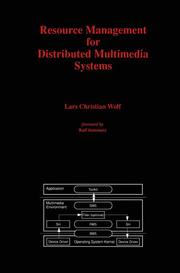Detailansicht
Resource Management for Distributed Multimedia Systems
ISBN/EAN: 9780792397489
Umbreit-Nr.: 1555145
Sprache:
Englisch
Umfang: xii, 146 S.
Format in cm:
Einband:
gebundenes Buch
Erschienen am 31.07.1996
- Zusatztext
- Resource Management for Distributed Multimedia Systems addresses the problems and challenges of handling several continuous- media data streams in networked multimedia environments. The work demonstrates how resource management mechanisms can be integrated into a stream handling system. The resulting system includes functions for Quality of Service (QoS) calculations, scheduling, determination of resource requirements, and methods to reduce resource requirements. The work explains the following: - a suitable system architecture and resource management scheme that allows for the provision and enforcement of QoS guarantee, resource scheduling mechanisms for CPU and buffer space, mechanisms to measure and collect resource requirements, methods to extend resource management to future scenarios by allowing the reservation of resources in advance and offering sealing mechanisms. . Resource Management for Distributed Multimedia Systems is a comprehensive view of resource management for a broad technical audience that includes computer scientists and engineers involved in developing multimedia applications.
- Kurztext
- This work addresses the problems and challenges of handling several continuous- media data streams in networked multimedia environments, demonstrating how resource management mechanisms can be integrated into a stream handling system.
- Autorenportrait
- Inhaltsangabe1. Introduction.- 1.1 Motivation.- 1.1.1 Characteristics of Audiovisual Data.- 1.1.2 Resource Availability.- 1.1.3 Resource Management.- 1.1.4 Environment.- 1.2 Related Work.- 1.3 Outline and Relevance of this Work.- 2. System Architecture of the Multimedia Environment.- 2.1 Related Multimedia Environments.- 2.2 Basic System Architecture.- 2.2.1 Characteristics.- 2.2.2 Components.- 2.3 Execution Structure.- 2.3.1 Real-Time and Non-Real-Time Environment.- 2.3.2 Processing Model Approaches.- 2.3.3 Used Processing Model.- 2.4 Stream Management.- 2.4.1 Stream Handlers and Stream Handler Graphs.- 2.4.2 Purpose of the Stream Management.- 2.4.3 Centralized versus Distributed Stream Management.- 2.4.4 Operations of the Stream Management.- 2.4.5 Applications.- 3. Resource Management Principles.- 3.1 Resources to be Managed.- 3.2 Needed Resource Management Functionality.- 3.3 End-to-End Resource Management.- 3.3.1 Resource Reservation Protocols.- 3.3.2 Usage of a Resource Reservation Protocol.- 3.4 QoS Model.- 3.4.1 Purpose of QoS Description.- 3.4.2 Acceptable QoS Values.- 3.4.3 Pessimistic vs. Optimistic Resource Management.- 3.4.4 Workload Model.- 3.4.5 QoS Parameters.- 3.5 Resource Management System Structuring.- 3.5.1 Basic Architecture.- 3.5.2 Internal Structure.- 4. Resource Scheduling.- 4.1 Buffer Space Management.- 4.1.1 Mechanisms and Structure.- 4.1.2 Buffer Space Reservation.- 4.1.3 Related Work.- 4.2 CPU Scheduling.- 4.2.1 Scheduling Algorithm.- 4.2.2 Implementation.- 4.2.3 Evaluation.- 4.2.4 Related Work.- 4.2.5 Summary.- 4.2.6 Possible Client System Enhancements.- 5. Determination of Resource Requirements.- 5.1 Resource Requirements of Applications.- 5.1.1 Distributed Approach.- 5.1.2 Centralized Approach.- 5.1.3 Differences Between Distributed and Centralized Approach.- 5.1.4 Centralized Approach - A Closer Look.- 5.1.5 Advanced Features.- 5.1.6 Communication Between Stream Handlers.- 5.1.7 Buffer Space.- 5.1.8 Related Work.- 5.1.9 Summary.- 5.2 Buffer Space Requirements.- 5.3 CPU Processing Time.- 5.3.1 CPU Utilisation of Multimedia Processes.- 5.3.2 Components of the Measurement Tool.- 5.3.3 Operation of the Measurement Tool.- 5.3.4 Measuring Sink and Source Stream Handlers.- 5.3.5 Accuracy of the Measurements.- 5.3.6 Evaluation.- 5.3.7 Position of the Measurement Tool in the System.- 5.3.8 Related Work.- 5.3.9 Summary.- 5.3.10 Possible Simplification via Better Operating System Support.- 6. Reduction of Resource Requirements.- 6.1 Buffer Space Requirements.- 6.1.1 Approaches to Reduce Memory Space Requirements.- 6.1.2 Notation.- 6.1.3 Buffer Pool Models.- 6.1.4 Simulation of the Buffer Pool Models.- 6.1.5 Simulation Results.- 6.1.6 Implementation Issues.- 6.1.7 Summary.- 6.2 CPU Requirements.- 6.2.1 Necessary Characteristics.- 6.2.2 System Model.- 6.2.3 Scheduling Mechanisms for Processes with Known Arrival Times.- 6.2.4 Scheduling Mechanisms for Processes with Varying Arrival Times.- 6.2.5 Evaluation.- 6.2.6 Related Work.- 6.2.7 Summary.- 7. Advanced Resource Management Techniques.- 7.1 Reserving Resources in Advance.- 7.1.1 Related Work.- 7.1.2 A Model for Resource Reservation in Advance.- 7.1.3 Issues in Resource Reservation in Advance.- 7.1.4 An Architecture Exploiting ReRA Mechanisms.- 7.2 Scaling.- 7.2.1 Related Work.- 7.2.2 Advantages of End-System Aware Scaling.- 7.2.3 Scaling Mechanisms.- 7.2.4 QoS Class for Scaling.- 7.2.5 Exploiting Scaling Mechanisms.- 8. Conclusions and Outlook.- Appendix A.- A.1 Abbreviations.- A.2 Trademarks.- References.
